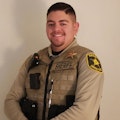How to Catch A Criminal: First, Do No Harm
I bring you this column out of my pure fascination with police work, cold cases, forensics, interrogation and all things criminal and mysterious. As an active-duty police officer, I hold an interest in all cases especially those that bring justice to light in the end. The purpose of this column is to tell the story of cases which were solved by technological advancements, unconventional tactics, dumb luck, and any other manner outside the norm. I hope you find these cases as intriguing and motivating as I do. This month, a spree killer's one night rampage and the strange role medical professionals played in his crimes and capture.
The phrase “First, do no harm”, is commonly associated with the medical field is often attributed to the ancient Greek doctor, Hippocrates, though it does not appear in the famed Hippocratic Oath. The purpose of the oath is essentially the same as that phrase. The Hippocratic Oath is a promise from doctors to always protect their patient's privacy, pass on their knowledge to the next generation of physicians, promote wellness, and avoid harming the people they are supposed to help. Similarly, The Nightingale Pledge, is taken by nurses, often at graduation, and includes a devotion to the welfare of those in their care as well as a promise to avoid anything that would cause harm to a patient. Unfortunately, the average citizen does not subscribe to such oaths. When it comes to living life, people are generally in it for themselves and will only go out of their way for their close friends and family, certainly not for strangers. Tragically, there are others still who will not just avoid helping others, but will actively harm others. Perhaps for their own enjoyment, financial gain, sexual gratification, or an uncontrollable rage brought on by drugs, alcohol, or mental illness. We know many of these people because they make headlines as serial killers, rapists, and organized crime kingpins, and rampage killers. A rampage killer is similar to a serial killer, but rather than strike repeatedly in different places at different times, a rampage killer attacks multiple victims in one place, in a single terrifying event.On the evening of July 13, 1966, a break-in occurred at a townhouse in the Jeffery Manor neighborhood. This townhouse was being used by a local nursing school to house students. Inside, the unsuspecting women went about their evening, unaware they were about to encounter the most horrific circumstances imaginable. The intruder made his way in through a window, armed with a revolver and a switchblade, and knocked on the door of the first bedroom he found. In that room he encountered group of three Filipino exchange students, Corazon Amurao, who answered the door, Merlita Gargullo, and Valentina Pasion. The exchange students were forced at gunpoint into a neighboring bedroom occupied by three American students, Patricia Matusek, Pamela Wilkening and Nina Jo Schmale. Using torn pieces of a sheet, the armed man bound each of the women's ankles together and their hands behind their backs. The man told them not to be afraid and that he needed money to get to New Orleans. One by one, the students were led out of the room while the remaining women waited, terrified. The American women told the exchange students to remain calm and cooperate, hoping he would just rob them and leave.
Each time the man returned alone, the women's worst fears bled into reality. Unbeknownst to the remaining students, their fellow students were being stabbed or strangled to death. Over and over, muffled screams could be heard from the latest victim in the other room before going quiet. While picking off the six students in the townhouse, the killer was interrupted when a seventh student came home. Suzanne Farris entered through the front door and headed upstairs to her bedroom, but the man heard her coming and ambushed her in the hallway, stabbing her to death. Some time later, Mary Ann Jordan came home and met the same fate. Last to come home that night was Gloria Jean Davy, who was sexually assaulted before being strangled. In between killing Farris, Jordan, and Davy, the man continued to return to the bedroom to deal with the remaining captive women. He continued this pattern until he finally left, thinking his hours long rampage left no one alive in the house. What the killer didn't realize was while he was switching back and for the between the first six women and the late three, he lost count. At some point, Corazon Amurao rolled under a bed and hid while the man was out of the room. He never noticed she had disappeared, and after hiding until 6 a.m. on July 14, Amurao ran to a window and screamed for help.
Police arrived and processed the nightmare crime scene which would later be heralded as the crime of the century. Though they did not have a suspect initially, police were able to obtain a description of the man from Ms. Amurao. This description led to a sketch of the man's face showing up in every newspaper and on every television station's nightly news. Aside, from the attacker's face, Amurao gave another crucial detail; the man who killed her fellow students had a very distinctive tattoo on his forearm which read “Born To Raise Hell.” While investigating the scene, Officers noted the style of knots used to bind the women were commonly used by sailors. A trip to the local Seaman's Union and description of the tattoo led them to the name “Richard Speck.” Just days later, 25-year-old Doctor LeRoy Smith, a surgeon at Cook County Hospital, called 911 to inform police a man identical to the sketch was brought to the hospital after an apparent suicide attempt in a hotel room. While examining the man's slit wrists, Dr. Smith noticed a forearm tattoo that gave him good cause to disregard patient privacy for the sake of justice. Police responded to the hospital and quickly confirmed the man was indeed Richard Speck.
Speck was born Dec. 6, 1941, in Kirkwood, Illinois, and raised briefly in nearby Monmouth. Under the rule of an abusive, drunken stepfather, Richard, his mother, and siblings, relocated to Santo, Texas, outside of Fort Worth in 1950. His family bounced around low income houses in Dallas from 1951 to 1962, at which time he married a young woman and had a daughter. A high school dropout and laborer by trade, Speck started building a lengthy rap sheet for things like disturbing the peace, forgery, and burglary. In 1965, Speck received a sixteen month sentence for aggravated assault after attacking a woman with a knife outside her apartment building. An error with the probation office resulted in Speck's release after just six months. In January of 1966 speak got into a knife fight with a man at one of his favorite dive bars, and received a whopping $10 fine. Specks refusal to pay the fine landed him three days in jail, but this sadly wasn't enough time to rehabilitate his criminal ways. In March of that year Speck robbed a grocery store and skipped town to avoid arrest. He returned to Illinois, settling in with his sister in Chicago.
After a short stay in Chicago, Richard paid a visit to his boyhood home of Monmouth. In April of 1965 he burglarized the home of 65-year-old Virgil Harris, binding and raping her in the process. Speck was also wanted for questioning in the death of a 32-year-old barmaid last seen on April 9, leaving one of Speck's usual haunts. Richard moved back with his sister in Chicago before police could catch up with him. His sister agreed to take him back after he told her he was on the run from a crime syndicate that was forcing him to sell drugs, a line he apparently wouldn't cross. Speck landed a job as an apprentice seaman, but after months without work opportunities he found himself staying in a sleazy hotel in July. Spending his time and money in nearby bars, Richard had devolved into broke, jobless drunk. On July 13, after a day of drinking, Richard pulled his switchblade on a 53-year-old woman, forcing her into his hotel room where he raped and robbed her, taking her .22 cal revolver. Speck grabbed dinner at a nearby restaurant and went back to drinking at his hotel's bar. Around 10 in the evening Speck left, drunk, armed with a switchblade and a revolver, and apparently up to no good. He walked over a mile until he came across the nursing student's townhouse. After he made his stop there, he soon returned to the hotel, where he continued drinking until he attempted suicide on July 17. As he sobered up and recovered from injuries in Cook County Hospital, he found himself strapped to the bed, surrounded by an army of police officers, and face to face with Corazon Amurao, who positively identified him as the man who killed her friends.
Despite his plea of not guilty, 49 minutes of jury deliberation led to a guilty verdict on all charges brought against Richard Speck for his rampage on the nursing students. He was sentenced to death, however law changes eliminated the death penalty, and his sentence was changed to an incredible 1,200 years in prison in 1972. Lucky for him, he later got his sentenced to reduced to 300 years. However, a heart attack would take Richard Speck's life in 1991 at the age of 49. Though his legacy was that of an out of control drunken murderer, Richard Speck unwittingly became a proponent of prison reform.
In 1996, a video tape, filmed in 1988, was anonymously sent to a Chicago news station. The video was filmed inside Stateville Correctional Center and showed a scene that would be shocking to see outside of a prison, let alone inside. The footage showed, Richard Speck, now sporting a more feminine physique thanks to hormones he had smuggled into the jail. Speck could be seen engaging in sexual acts with another inmate, as well as snorting cocaine from a tray. The inmate filming asked Speck if he really did murder the nursing students. He went on to say he did, and that he didn't feel remorse for it, adding that “it just wasn't their night”. Speck also proudly states that he would be released if “they” knew how much fun he was having in prison. This footage was passed on to the Illinois State Legislature, who were of course curious how this kind of behavior and contraband could exist inside the prison, especially around a man who should be under and extremely watchful eye at all times. As a result of the subsequent investigation, there was a major crackdown on inappropriate inmate behavior, increased searches of all people coming into the facility, including visitors and employees, and harsher penalties implemented for possession of contraband, including cameras, drugs, and hormones. Incarcerated persons, much like hospital patients, are in the care of the staff and facility in which they are held. Regardless of what they have done, they too deserve the best level of care and to be protected from harm.
About the Author
Brendan Rodela is a Deputy for the Lincoln County (NM) Sheriff's Office. He holds a degree in Criminal Justice and is a certified instructor with specialized training in Domestic Violence and Interactions with Persons with Mental Impairments.
About the Author

Officer Brendan Rodela, Contributing Editor
Brendan Rodela is a Sergeant for the Lincoln County (NM) Sheriff's Office. He holds a degree in Criminal Justice and is a certified instructor with specialized training in Domestic Violence and Interactions with Persons with Mental Impairments.

